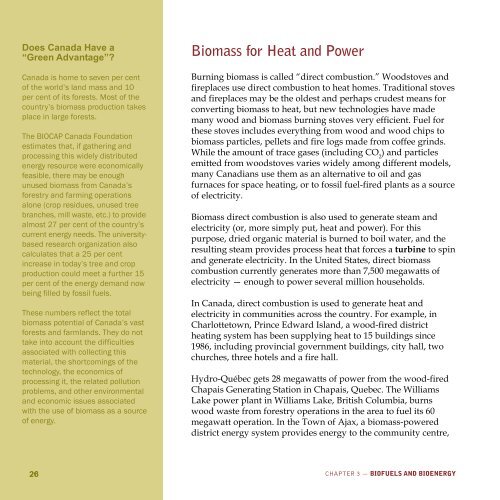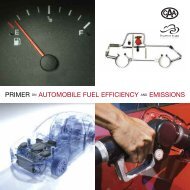Primer on Bioproducts - BIOCAP Canada
Primer on Bioproducts - BIOCAP Canada
Primer on Bioproducts - BIOCAP Canada
Create successful ePaper yourself
Turn your PDF publications into a flip-book with our unique Google optimized e-Paper software.
Does <strong>Canada</strong> Have a“Green Advantage”?<strong>Canada</strong> is home to seven per centof the world’s land mass and 10per cent of its forests. Most of thecountry’s biomass producti<strong>on</strong> takesplace in large forests.The <strong>BIOCAP</strong> <strong>Canada</strong> Foundati<strong>on</strong>estimates that, if gathering andprocessing this widely distributedenergy resource were ec<strong>on</strong>omicallyfeasible, there may be enoughunused biomass from <strong>Canada</strong>’sforestry and farming operati<strong>on</strong>sal<strong>on</strong>e (crop residues, unused treebranches, mill waste, etc.) to providealmost 27 per cent of the country’scurrent energy needs. The universitybasedresearch organizati<strong>on</strong> alsocalculates that a 25 per centincrease in today’s tree and cropproducti<strong>on</strong> could meet a further 15per cent of the energy demand nowbeing filled by fossil fuels.These numbers reflect the totalbiomass potential of <strong>Canada</strong>’s vastforests and farmlands. They do nottake into account the difficultiesassociated with collecting thismaterial, the shortcomings of thetechnology, the ec<strong>on</strong>omics ofprocessing it, the related polluti<strong>on</strong>problems, and other envir<strong>on</strong>mentaland ec<strong>on</strong>omic issues associatedwith the use of biomass as a sourceof energy.Biomass for Heat and PowerBurning biomass is called “direct combusti<strong>on</strong>.” Woodstoves andfireplaces use direct combusti<strong>on</strong> to heat homes. Traditi<strong>on</strong>al stovesand fireplaces may be the oldest and perhaps crudest means forc<strong>on</strong>verting biomass to heat, but new technologies have mademany wood and biomass burning stoves very efficient. Fuel forthese stoves includes everything from wood and wood chips tobiomass particles, pellets and fire logs made from coffee grinds.While the amount of trace gases (including CO 2) and particlesemitted from woodstoves varies widely am<strong>on</strong>g different models,many Canadians use them as an alternative to oil and gasfurnaces for space heating, or to fossil fuel-fired plants as a sourceof electricity.Biomass direct combusti<strong>on</strong> is also used to generate steam andelectricity (or, more simply put, heat and power). For thispurpose, dried organic material is burned to boil water, and theresulting steam provides process heat that forces a turbine to spinand generate electricity. In the United States, direct biomasscombusti<strong>on</strong> currently generates more than 7,500 megawatts ofelectricity — enough to power several milli<strong>on</strong> households.In <strong>Canada</strong>, direct combusti<strong>on</strong> is used to generate heat andelectricity in communities across the country. For example, inCharlottetown, Prince Edward Island, a wood-fired districtheating system has been supplying heat to 15 buildings since1986, including provincial government buildings, city hall, twochurches, three hotels and a fire hall.Hydro-Québec gets 28 megawatts of power from the wood-firedChapais Generating Stati<strong>on</strong> in Chapais, Quebec. The WilliamsLake power plant in Williams Lake, British Columbia, burnswood waste from forestry operati<strong>on</strong>s in the area to fuel its 60megawatt operati<strong>on</strong>. In the Town of Ajax, a biomass-powereddistrict energy system provides energy to the community centre,26CHAPTER 3 — BIOFUELS AND BIOENERGY
















